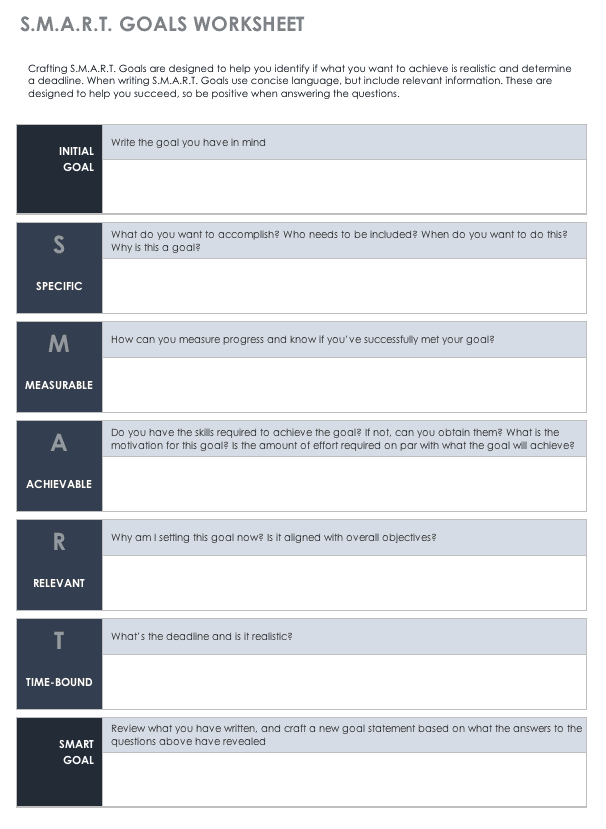SMART goals are created using a certain set of standards or measures which ensure that your aims are achievable within a specific time. SMART is an acronym that you can use to guide the setting of your goals. To ensure that your goals are achievable and clear, each has to be:
Specific (sensible, simple, significant).
Measurable (motivating and meaningful).
Achievable (attainable, agreed).
Relevant (realistic and resourced, reasonable, result-based).
Time-bound (time-sensitive, time/cost limited, time-based, timely).
In writing a SMART goal, you have to work through each of the five elements to build a goal that is quantifiable which comprises exactly what you are required to accomplish, when it is due, as well as how to know when your goal is successful. This method is implemented to remove speculations and generalities, and it sets a distinct timeline that makes it simpler to monitor progress and know when you miss a milestone.
How to write SMART goals
So, how can this acronym assist you while setting your goal?
S- Specific
For a goal to be effective, it must be specific. Do not ignore the littlest detail. A specific goal provides answers to questions such as:
What objectives are you required to accomplish?
Who is in charge of it?
What steps will you take to accomplish it?
Putting these questions into consideration will assist you in setting a goal that is achievable, describes your aims, and gives you that crucial context.
For example, if you are a marketer and you aim to become the marketing head, there are specific goals you need to follow. The specific goal can include gaining the skills and working experience that are required for you to be the marketing head within your organization to build your career and help you lead a successful team.
M- Measurable
An objective must have a criteria or basis for measuring progress. This criteria will be used to determine and track when you’ve achieved your objective.
Quantifying your goals (i.e. ensuring that your goals are measurable) makes it much simpler to monitor your progress and know once you get to your goal.
A goal that is measurable should answer questions like:
How much?
How many?
How do I know once it is achieved?
For example, you can quantify your goal of getting the skill, to be the head of marketing by setting a target that by a particular time, you would have finished the necessary training courses and gained the needed experience.
A- Achievable
It is important that your goals are realistic, not some far-fetched fairy tales. For something to be achievable means making sure that your goal is something within your reach (sometimes, “A” can be used to represent “attainable”). Simply put, this is the point in the whole process when you critically check yourself if your goal can really be achieved.
You ask yourself questions such as:
Is the goal you’re aiming attainable?
Is it something your team can successfully accomplish?
How achievable is the goal considering other factors that can restrain you such as financial factors?
It is crucial to check any limitations that may hinder your goal.
For instance, there may be a need for you to question yourself if developing the needed skill to become the marketing head is realistic considering your prior experience and qualification. For example, do you have the required time to finish the training effectively? Do you have the necessary resources? Do you have enough funds to get the training?
R – Relevant
No one sets a goal just out of a joke or for no reason. There must be a genuine benefit that comes with attaining your chosen goal. That is what we mean by “relevant”. In this step, you check why the goal is important to you and your organization. Immediately you know this important benefit, ensure you include it in your SMART goal so that everyone can envision your big picture. Therefore, ensure that your plans move everybody forward, but that you are still the one responsible for attaining this goal.
A relevant goal can provide a positive answer to the following questions:
Does this goal worth it?
Is this the appropriate time?
Does this suit your other needs or efforts?
Are you the right person to reach this goal?
For instance, you may want to have the skills to be the head of marketing within your company, however, is it the appropriate time to take the required training or gain another qualification? Are you sure that you are the best person for the role of marketing head? And so on.
T- Time-bound
Good goals will not take forever to achieve, i.e. they have a due date. The last element of SMART goals is that they are supposed to be time-bound (sometimes referred to as “timely” or “time-based”). This is another essential way of measuring success. You and your team should be unanimous about when a goal should be achieved. Your SMART goals must have standards that are time-related, so everyone knows how to be on track within an appointed time.
A time-bound goal will always answer the following questions:
When?
What can I achieve within six months/a stipulated time?
What can I do today?
For example, acquiring the skills to be the head of marketing may require more training or experience, as stated before. What is the span of taking these required skills? Is further training required to qualify you for a particular examination or qualification? It is crucial to give yourself a time frame that is realistic for you to attain the smaller goals that are required to attain your financial objective.
SMART is an efficient tool that gives you:
Clarity, motivation, and focus that you require to accomplish your goals. It can as well better your ability to get them by encouraging you to clearly define your aims and set a due date. SMART goals are also simple for anyone, anywhere to use without any training or special tools.
So many interpretations of SMART have indicated that it can reduce its efficiency or be misinterpreted. Some individuals are of the opinion that SMART does not work effectively for long-term goals because it is not flexible, while others suggest that it can repress creativity.
How to accomplish your goals
Now that you are familiar with how to write SMART goals, knowing how to accomplish them is a totally different problem. You have already made a commendable first step by making use of the SMART approach to set achievable, measurable, result-oriented targets. However, there are other few steps to take which will set your team up for success.
Put down your goal in writing
What next after establishing your goals? Are you supposed to just allow it to rattle around in your brain till it is done and over? The answer is “NO.” You need to write it down. Penning your goal down serves as a strong reminder of what you and your team members are working towards.
Set constant check-ins
We all know the rush of excitement we feel once we are about to face something different. But immediately you get a little ahead, that feeling fades away before you know it – it is the reason many resolutions are forgotten before they are attained. Any goal that is worth accomplishing may not happen suddenly, and it is crucial that you check in on your progress from time-to-time to make sure you are not off track. Having regular reminders and opportunities for feedback will ensure that everyone is duly motivated, which is very important for bigger business goals that are long-term.
Celebrate your victories (even the little ones)
Do not wait till you achieve your goal as a whole before you celebrate; recognizing little wins and milestones can keep you moving in the best direction.
We will not bore you with the in-depth science lesson, however, basically, there is a dopamine spike whenever you anticipate something crucial is about to occur (such as achieving something that you set out to do). This is what triggers you to be motivated. Therefore, by setting little, gradual goals and then giving yourself a virtual hug once you accomplish them, you can make the dopamine spikes increase, which in turn drives you to remain focused.
SMART goals template

All goals are not the same or have a similar objective. Unclear goals make you wonder what to do next and how to quantify your success. Understanding how to set goals with the use of the SMART approach gives the details and context that are required beforehand. A great news is that setting SMART goals is not difficult at all. Just go through each letter of the acronym and answer the questions based on your own objectives. By ensuring the goals you set are in line with the SMART approach (Specific, Measurable, Achievable, Relevant as well as Time-bound), you have a solid ground on which you can build your focus as well as the decisions you make. Once your SMART goal is accomplished, you can scale up and begin, rest assured there is a great backbone to your strategy.
Published: February 27, 2021





